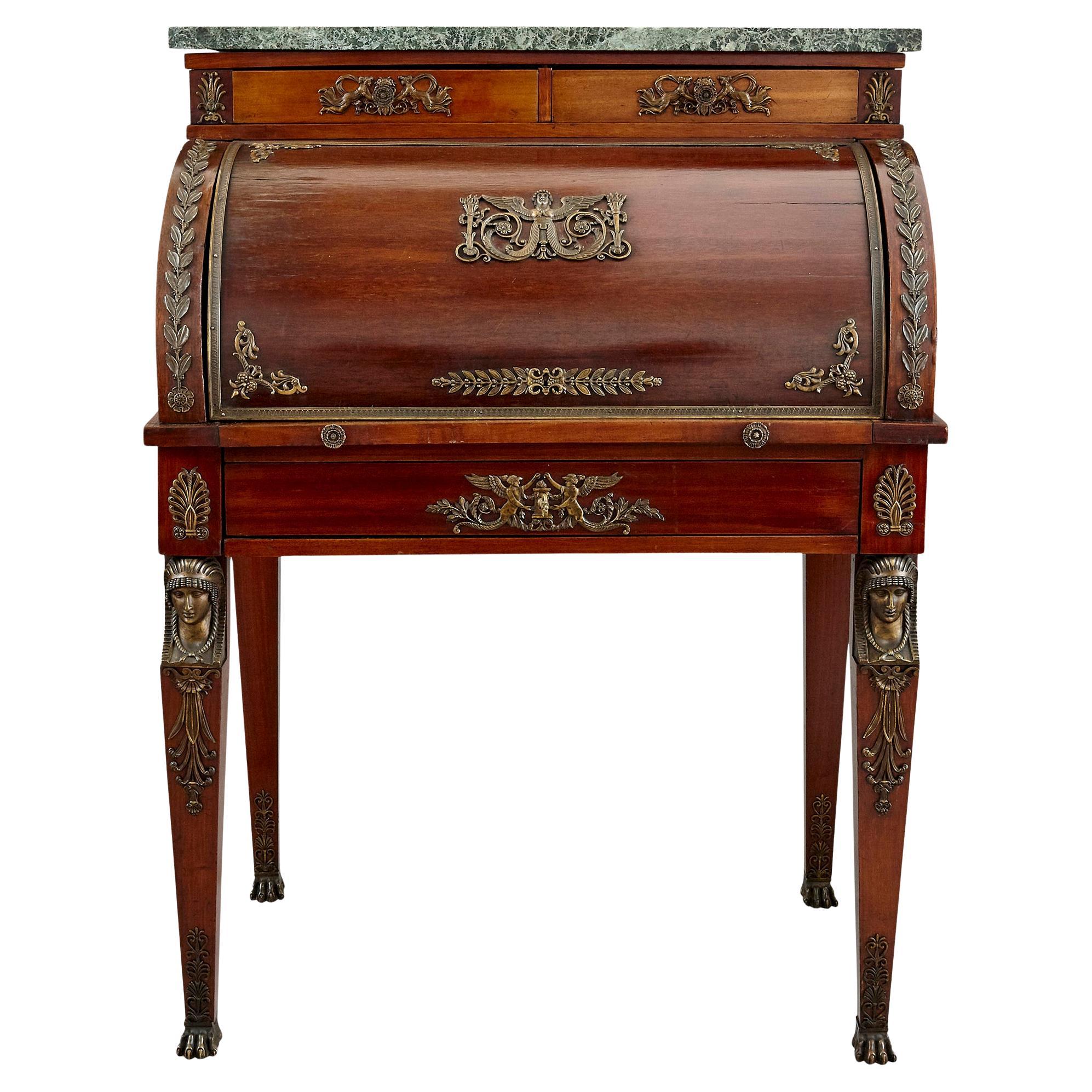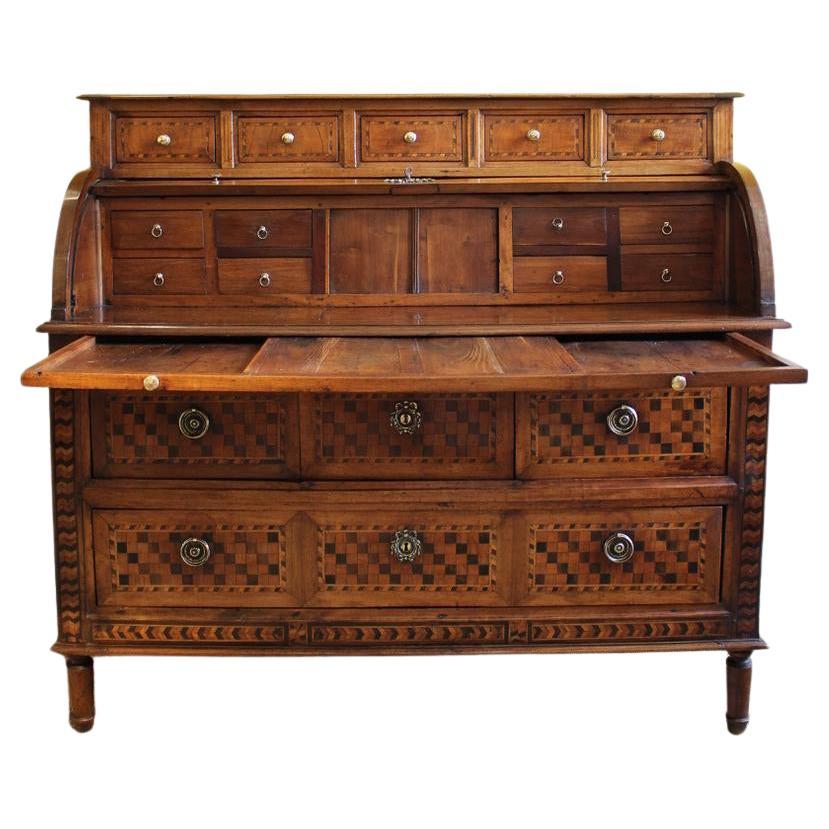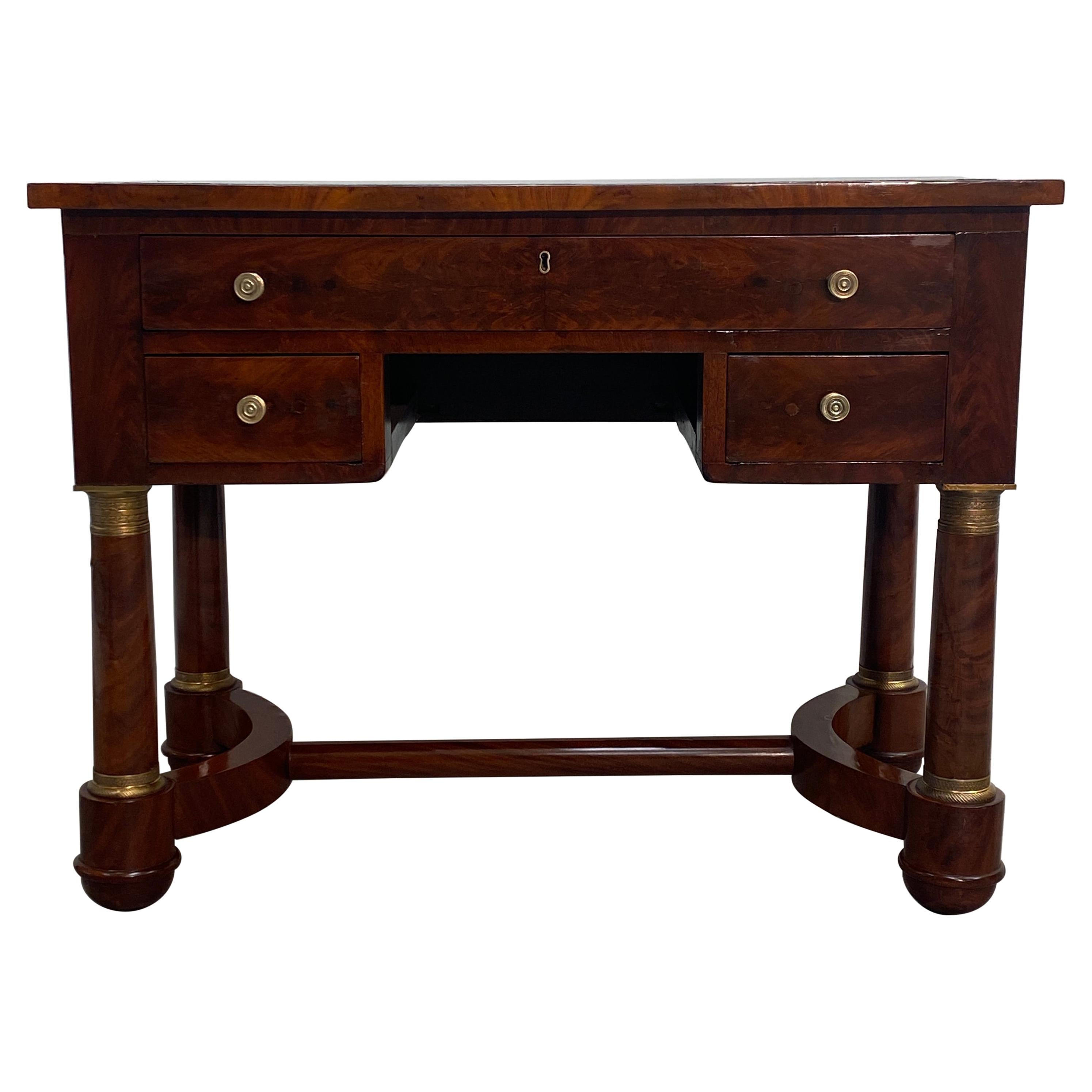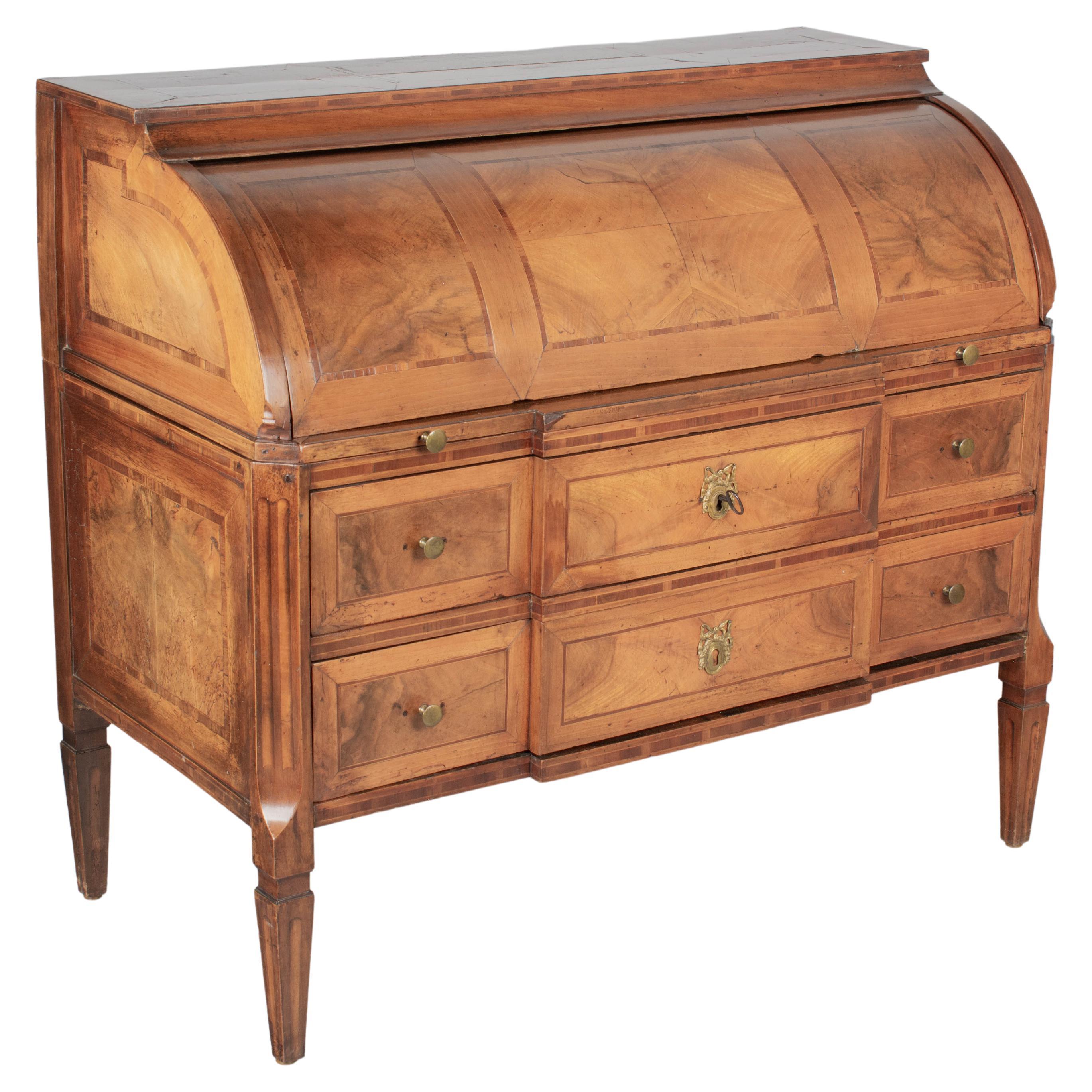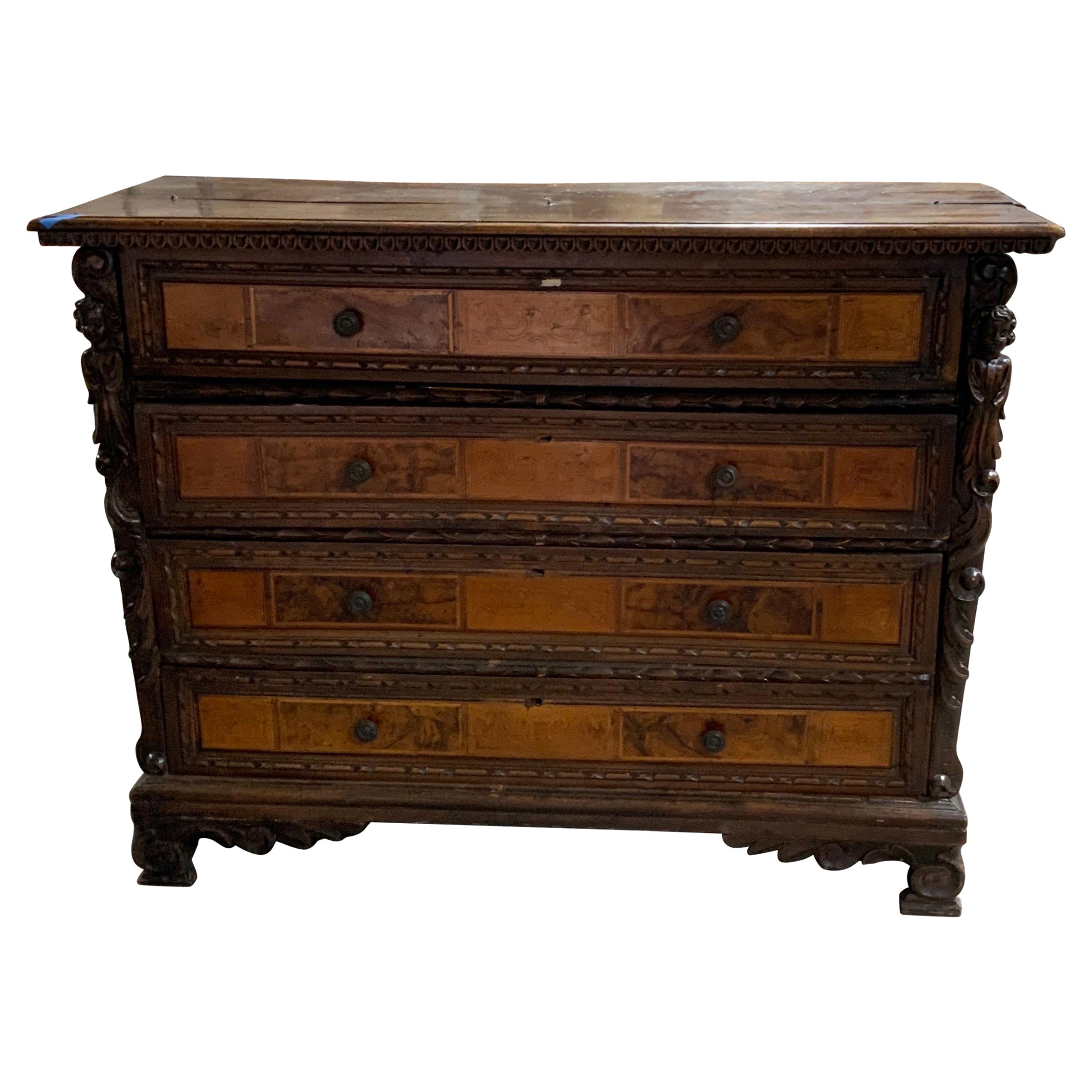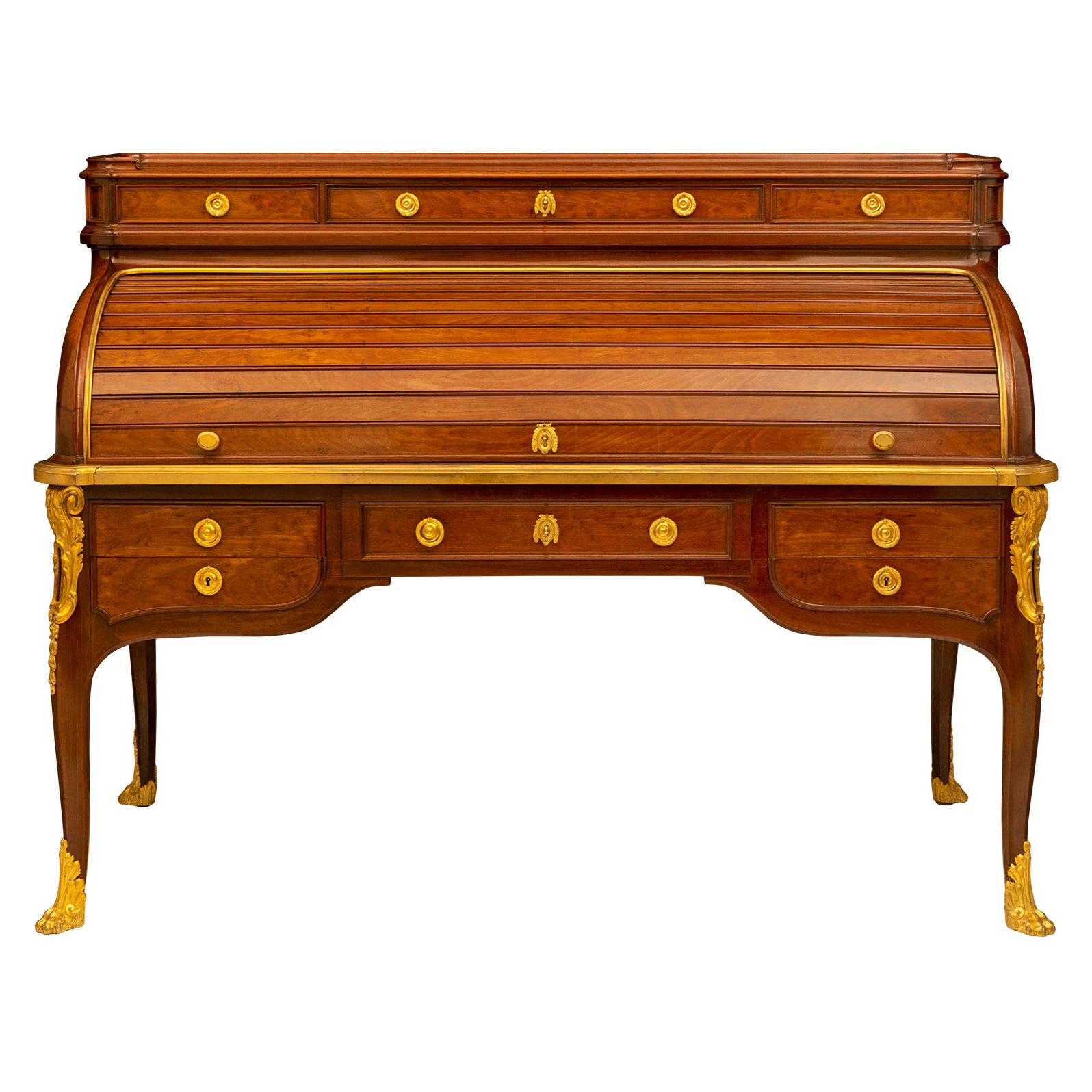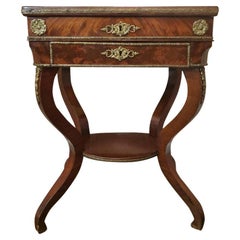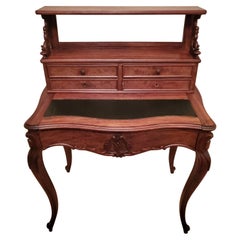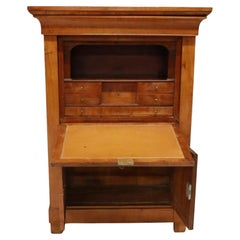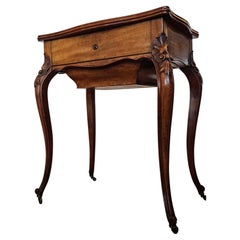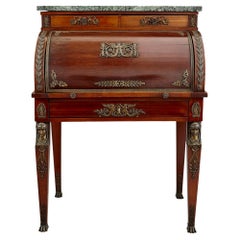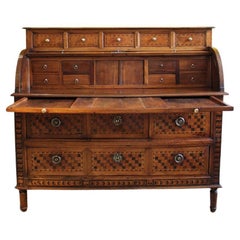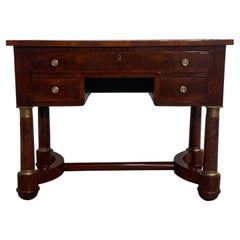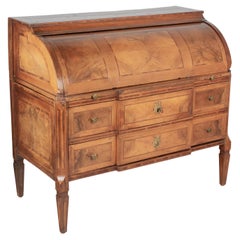Items Similar to Early 19th Century French Empire Period Bureau a Cylindre Gentleman's Desk
Want more images or videos?
Request additional images or videos from the seller
1 of 11
Early 19th Century French Empire Period Bureau a Cylindre Gentleman's Desk
$9,500
£7,053.24
€8,218.97
CA$13,189.07
A$14,752.80
CHF 7,677.45
MX$181,612.02
NOK 97,673.01
SEK 91,636.54
DKK 61,321.72
Shipping
Retrieving quote...The 1stDibs Promise:
Authenticity Guarantee,
Money-Back Guarantee,
24-Hour Cancellation
About the Item
A exceptionally rare Period French Empire (1804-1814) walnut bureau a cylindre.
Exquisitely hand-crafted in France, most likely Parisian work, dating to the early 19th century, the large antique cylinder desk features a tambour roll top, opening to reveal an interior gallery fitted with small drawers and open shelf pigeonhole cubbies for writing instruments and documents. Having an extended writing surface, above rectangular case fitted with a frieze drawer over two large drawers with hand-cut dovetail joinery, flanked by classical ebonized double columns, mounted with patinated gilt bronze Egyptianesque masks (paying homage to Napoleon Bonaparte's recent 1798–1801 military campaign in Egypt), rising on tapered square legs. circa 1810
Dimensions: (approx)
44.25" High, 51.5" Wide, 24.25" Deep
A superb museum quality example. Excellent original unrestored antique condition. Nicely aged patina. Retaining antique character throughout, including typical age appropriate wear.
Delivered cleaned, waxed, with hand rubbed polished French patina, ready for immediate use and generational enjoyment.
- Dimensions:Height: 44.25 in (112.4 cm)Width: 51.5 in (130.81 cm)Depth: 24.25 in (61.6 cm)
- Style:Empire (In the Style Of)
- Materials and Techniques:
- Place of Origin:
- Period:
- Date of Manufacture:circa 1810
- Condition:Wear consistent with age and use. A superb museum quality example. Excellent original unrestored antique condition. Nicely aged patina. Retaining antique character throughout, including typical age appropriate wear.
- Seller Location:Forney, TX
- Reference Number:1stDibs: LU5977232582442
About the Seller
4.8
Platinum Seller
Premium sellers with a 4.7+ rating and 24-hour response times
Established in 2013
1stDibs seller since 2021
290 sales on 1stDibs
Typical response time: 1 hour
- ShippingRetrieving quote...Shipping from: Forney, TX
- Return Policy
Authenticity Guarantee
In the unlikely event there’s an issue with an item’s authenticity, contact us within 1 year for a full refund. DetailsMoney-Back Guarantee
If your item is not as described, is damaged in transit, or does not arrive, contact us within 7 days for a full refund. Details24-Hour Cancellation
You have a 24-hour grace period in which to reconsider your purchase, with no questions asked.Vetted Professional Sellers
Our world-class sellers must adhere to strict standards for service and quality, maintaining the integrity of our listings.Price-Match Guarantee
If you find that a seller listed the same item for a lower price elsewhere, we’ll match it.Trusted Global Delivery
Our best-in-class carrier network provides specialized shipping options worldwide, including custom delivery.More From This Seller
View All19th C. French Charles X Restoration Period Sewing Stand Work Table
Located in Forney, TX
A scarce period Charles X (1818-1834) French Restoration mahogany travailleuse sewing (thread stand - side table - jewelry dressing table) with light, warm, beautifully aged patina.
Born in France in the early 19th century, almost certainly Parisian work, exquisitely hand-crafted, this exceptionally executed example features ornate gilt bronze ormolu mounts, escutcheons, and elaborate gilt metal trim. Having a highly figured light mahogany hinged lid top, lifting open to reveal a striking finished interior with divided compartments and original inset mirror plate. The conforming rectangular case fitted with a faux drawer front over a dovetailed drawer with sectioned interior. Elegantly rising on oval-shaped medial shelf stretcher-joined curvacious legs.
Dimensions (approx):
27" High, 20" Wide, 13.5" Deep
Stunning light almost blonde antique mahogany coloring and mellow warm tone, superb wood grain detail, and charming, beautifully aged patina over the whole. Great shape overall. Retaining original antique character marks, wear consistent with age and indicative of minimal use, nothing that detracts from the aesthetics or functionality, but only adds to the overall authenticity, refined elegant warmth, luxurious sophistication, and cozy unpretentious rustic elegance.
Delivered cleaned, hand waxed, polished French patina finish, ready for immediate use and generational enjoyment!
What is Charles X style:
The comte d’Artois – or Charles X - was the son of the dauphin Louis-Ferdinand de Franc and Marie-Josèphe de Saxe. He succeeded his two brothers Louis XVI and Louis XVIII and became the King of France in 1824. Thirty years after the French Revolution, he wanted to embody the return of monarchy and became the leader of the catholic party . As the previous kings, he was crowned in 1825 but he was soon overthrown by the revolution in July, 1830, called "Trois Glorieuses". He left then for England, Scotland, Prague and Istria where he died in 1836.
Charles X style lasted from 1818 to 1834 and happened during the Bourbon Restoration (French Restoration). This style did not replace totally the style of furniture from the French Empire but it was different from the formalism in the Napoleonic era, during which strictness and simplicity were inspired by Greco-Roman art. Indeed, artistic fields flourished. In terms of furniture, this renewal was suggested by the softening of shapes. Even though the simple aspect from the French Empire was still visible, shapes became curvier with volutes and arabesques. Another distinction is the loss of the massive aspect of furniture and the decrease of dimensions in order to decorate smaller appartments. Handling ability and comfort were key-words in the making of furniture. Apartments had essential elements such as chests of drawers, big rounded tables in the dining room, desks or secretaries, armoires and even dressing tables, comfortable fainting couches in the living room, small tables, pedestal tables, as well as gondola chairs. The wavy aspect of the latters certainly represent Charles X style the best.
One of the most emblematic features of this style is the use of bois clairs – light woods in warm blond tones - and indigenous woods that are varnished in order to highlight the grains. Bird's-eye maple, ash trees, plane trees, yew trees, beech trees, olive trees and cedar trees were most likely to be used. Indeed, at the beginning of the 19th century dark woods were hard to find. In 1806, the Napoleon’s Continental System was established in order to ruin the United Kingdom by preventing the country from any business with the rest of Europe. Therefore craftsmen had to find alternatives from mahogany which was the most commonly used material at this time. After 1815, the import of wood was even more difficult because of peace treaties and the European political situation, which contributed to the popularity of the bois clairs and indigenous woods. The furniture was often decorated with fine inlays made out of dark wood representing foliage, which contrasted with the veneer. Even though these patterns can look like bronze decorations from the Empire era, they were far more simple and did not represent any military or mythological attributes. On the tables, trays were sometimes made out of marble as in the French Empire, but it was often put aside and inlaid veneer, Verre Eglomisé – a type of glass with a mirror finish –, mirror or porcelain from Sèvres or Paris were more likely to be used.
Decorative elements from the Monarchy were highly appreciated again as they suggested luxury. Indeed, marquetry work was particularly fashionable - Boulle marquetry thrived around 1820 as the works of the Levasseur family can show. In the same way, draperies and trimmings referred to the monarchist splendour. Fabrics were often white – the traditional colour of the Bourbons – or light coloured as oppposed to the typical green from the Napoleonic era.
One of the most symbolic figures from this period of time might be Jean-Jacques Werner (1791-1849), a cabinetmaker who worked for prestigious clients such as the Duchesse de Berry who was Charles’s step-daughter. His works can be seen at the Musée des Arts Décoratifs and at the Grand Trianon in the Palace of Versailles. The duchess’s appartments situated at the pavillon de Marsan and at the Palais de Saint Cloud illustrate Charles X style the best with furniture made out of bois clairs and ornamented with dark wood patterns or fine gold decorations.
Chales X style allows a transition between the sobriety of the Empire style and the abundant aspect of Louis-Philippe style. The gothic style started at this time through the "style à la cathédrale", inspired by religious architecture, which thrived from 1827 to 1830. Indeed, at the beginning of the 19th century, Romanticism put the spotlight on the Middle Ages. Cabinetmakers were not inspired by the medieval furniture but rather by architectural elements of churches and cathedrals. For instance the backs of chairs were decorated with arches shaped like rib and serration. In the same way, before Charles X abdicated, pieces of furniture were made out of dark woods – such as mahogany, which was used again in France – and were inlaid with light wood. Romanticism also influenced the layout of furniture in appartments to suggest movement through a mix of various styles, various shapes and various sizes, as opposed to the static aspect of Neoclassicism. The start of industrialisation and mechanisation also influenced this style as early technical developments led to the production of pieces of furniture in series.
Credit:
Marc Maison
Bibliography:
FANIEL Stéphane (Dir.), Le Dix-neuvième Siècle Français, Collection Connaissance des Arts, 1957, Hachette
SASSONE, Adriana Boidi, Furniture from Rococo to Art Deco, 2000, Evergreen
--
Extremely versatile:
As warm and attractive as it is useful, this remarkable antique table having the ideal size and small proportions for a variety of different uses, including as a side table, accent or occasional table, tall sofa...
Category
Antique Early 19th Century French Charles X End Tables
Materials
Bronze, Ormolu
Period French Napoleon III Mahogany Bonheur Du Jour Antique Ladies Writing Desk
Located in Forney, TX
A charming Napoleon III Second Empire Period (1852-1870) mahogany Bonheur Du Jour de dame(ladies writing desk) circa 1860
Hand-crafted in France the third quarter of the 19th centur...
Category
Antique Mid-19th Century French Napoleon III Desks and Writing Tables
Materials
Leather, Mahogany
19th C. French Empire Style Louis Philippe Period Secretaire Abattant
Located in Forney, TX
A Louis Philippe period (1830–1848) fruitwood secretaire abattant fall front desk.
Born in France in the mid-19th century, hand-crafted of rich solid fruitwood with warm wood tones, subtle grain detail, and nicely aged mellow patina over the whole. Finished in French Empire taste, having a molded cornice, concealed ogee frieze drawer with dovetail joinery, over fall front panel, opening to reveal original fitted interior gallery, with inset gilt tooled leather writing surface, large open shelf cubby, six drawers of various size, above double-door cabinet with brass shield escutcheon that opens to provide generous storage space, and an additional lower drawer for valuables hidden in the base molding, rising on square feet.
Dimensions: (approx)
56.75" High 41" Wide, 17.5" Deep
History/Back Story:
Louis Philippe furniture had the same types and forms as the earlier French Restoration style, but with less decoration; comfort was the primary consideration.
During the turbulent French Revolution and following Napoleon rule, Louis Philippe (1773-1850) remained in exile for 21 years until the Bourbon Restoration, when he became the King of the French from 1830 to 1848.
For the first time, the developing upper class–not the monarchy–influenced the progression of this style’s characteristics.
However, King Louis Philippe’s personality still inspired many aspects. His casual nature reflected this style’s informal, comfortable build. Much of the style was taken from the personality of the King himself. Unlike his Bourbon predecessors, he wore business dress...
Category
Antique Mid-19th Century French Louis Philippe Secretaires
Materials
Leather, Fruitwood
Antique French Ledet et fils Louis XV Ladies Sewing Work Table Dressing Vanity
Located in Forney, TX
Refined country French elegance and sophistication at its finest, this Provincial Louis XV style lady's sewing stand work table or coiffeuse by Ledet et fils exudes refined grace and functionality.
Born in Bordeaux Region of Southwestern France in the mid-19th century, exceptionally executed in sophisticated King Louis Fifteenth (1715-1774) taste, hand-crafted of warm mellow solid mahogany, having a rectangular serpentine shaped hinged top opening to reveal the original flat mirror plate, over a removable divided tray, faux drawer front with wooden escutcheon, above a sewing / work bin, gently curved scalloped apron, all rising elegantly on long cabriole legs adorned with finely carved shell acanthus leaf knee ending in whorl feet, terminating on casters. circa 1850s
Signed, retaining the original ébéniste (cabinetmakers) makers mark to the underside, reading:
Ledet
Fab de Meubles
Bordeaux
Dimensions: (approx)
29.25" High, 24" Wide, 16.75" Deep
Versatile:
As warm and attractive as it is useful, having the ideal size and proportions for a variety of different uses, including as a side table, accent table, hall console, sofa table, bedside nightstand, rolling lamp...
Category
Antique Mid-19th Century French Louis XV Side Tables
Materials
Wood, Mahogany
19th Century French Empire Style Bronze Mounted Bureau Plat Writing Desk
Located in Forney, TX
A handsome antique French gilt bronze mounted mixed wood bureau plat writing desk with warm dark patina. circa 1880
France, late 19th century, high quality
hand crafted workmanship...
Category
Antique Late 19th Century French Empire Desks and Writing Tables
Materials
Metal, Brass, Bronze, Ormolu
Maison Forest Signed French Louis XVI Style Writing Table - Late 19th Century
By Maison Forest
Located in Forney, TX
A rare and very fine quality 19th century French bureau plat by renowned Parisian ébéniste Maison Forest.
Maison Forest is one of the most famous french cabinetmakers of the 19th a...
Category
Antique Late 19th Century French Louis XVI Desks and Writing Tables
Materials
Bronze, Ormolu
You May Also Like
Early 20th Century French Empire Style Roll-Top Desk
Located in London, GB
Early 20th century French Empire style roll-top desk
French, Early 20th Century
Height 113cm, width 84cm, depth 62cm
This charming roll-top desk is crafted from ormolu mounted hardw...
Category
Early 20th Century French Empire Desks and Writing Tables
Materials
Marble, Ormolu
Wonderful 18th Century French Roll Top Desk (Cylinder Bureau)
Located in Poole, GB
Wonderful 18th Century French Roll Top Desk ( cylinder bureau )
A very elegant and with great proportions, late 18th century French walnut and pa...
Category
Antique Late 18th Century French Desks and Writing Tables
Materials
Walnut
Early 19th Century French Empire Desk
Located in Nashville, TN
Mahogany veneered French Empire desk. Leather insert top. Brass hardware on column legs and bun feet. Very unique and good quality period French des...
Category
Antique 1810s French Empire Desks
Materials
Mahogany
$2,640 Sale Price
51% Off
19th Century Louis XVI Bureau à Cylindre or Roll Top Desk
Located in Winter Park, FL
A fine early 19th century Louis XVI period bureau à cylindre, or roll top desk, made of solid walnut with marquetry veneers of walnut, mahogany and cherry. Pine as a secondary wood. ...
Category
Antique Early 19th Century French Louis XVI Desks and Writing Tables
Materials
Brass
Mid-19th Century French Butlers Desk
Located in Dallas, TX
This beautifully detailed item is made of oak with inlay mahogany. Item dates back to the 1850s and contains many drawers inside of fall-front.
Category
Antique Mid-19th Century French Desks and Writing Tables
Materials
Mahogany, Oak
French 19th Century Transitional St. Bureau À Cylindre Desk
Located in West Palm Beach, FL
An impressive and palatially scaled French 19th century Transitional st. Moucheté Mahogany and ormolu Bureau à Cylindre desk. The exceptional thirteen dr...
Category
Antique 19th Century French Desks
Materials
Ormolu
